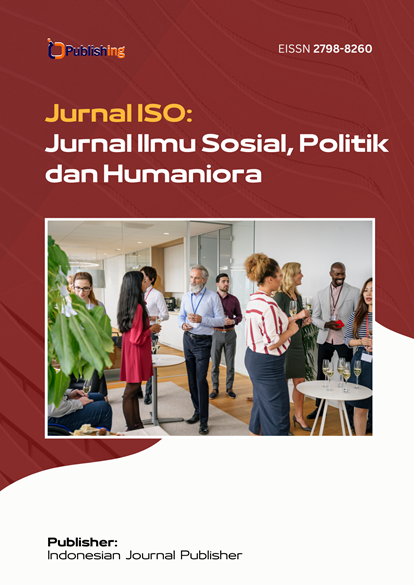Poverty Data Revolution: Analyzing The Effectiveness Of Damsida Application in Bojonegoro District
DOI:
https://doi.org/10.53697/iso.v4i2.1969Keywords:
Effectiveness, Damsida, PovertyAbstract
The DAMISDA application was developed by the Bojonegoro Regency Government to address data accuracy challenges in poverty alleviation, aiming to facilitate effective social assistance targeting. This study examines DAMISDA's effectiveness through three primary indicators: goal achievement, integration, and adaptation. A descriptive qualitative approach was employed, incorporating in-depth interviews, observations, and document analysis to assess the application’s performance. Findings indicate that DAMISDA has enhanced poverty data accuracy, aiding precise targeting in social assistance distribution. However, issues such as inclusion errors and network instability hinder optimal efficiency, affecting data updates and timely interventions. The integration process is supported by clear procedures and extensive socialization efforts, though network limitations impact seamless implementation. Adaptation efforts, including operator training, have improved application usage, but technological infrastructure constraints remain a significant challenge. The study underscores DAMISDA's potential as a model for data-driven poverty interventions, suggesting policy improvements in infrastructure and validation processes. This research contributes to e-government literature by highlighting the role of digital tools in poverty management, particularly in rural Indonesia. Further exploration is recommended to evaluate DAMISDA’s adaptability in broader contexts, contributing to more resilient and accessible digital platforms for targeted poverty alleviation.
References
Agustina, M., Majid, M., Faisal, F., & Musnadi, S. (2023). Does islamic banking sector matter for income disparity reduction? empirical evidence from indonesia. International Journal of Professional Business Review, 8(5), e01475. https://doi.org/10.26668/businessreview/2023.v8i5.1475
Amida, O., & Sitorus, J. (2021). Penerapan Regresi Logistik Biner Multilevel Dalam Analisis Pengaruh Karakteristik Individu, Rumah Tangga, Dan Wilayah Terhadap Status Kemiskinan Balita Di Kepulauan Maluku Dan Pulau Papua. Seminar Nasional Official Statistics, 2020(1), 967-977. https://doi.org/10.34123/semnasoffstat.v2020i1.569
Aziz, I.R. (2022). Efektivitas Aplikasi Sigertak+ Sebagai Media Penyusunan Kebijakan Penanggulangan Kemiskinan Di Provinsi Sumatera Selatan. Skripsi. http://digilib.unila.ac.id/63067/
Duun, P., & Steers, R. (2002). Organizational effectiveness: A behavioral view. McGraw-Hill.
Faradis, R. (2023). Poverty line based on the large archipelagic area in indonesia in taking poverty alleviation policies. Jurnal Ilmu Ekonomi Terapan, 8(2), 222-235. https://doi.org/10.20473/jiet.v8i2.46331
Firmansyah, A. (2023). Dampak pendidikan terhadap pengentasan kemiskinan di indonesia dengan menggunakan analisis data panel. ESDS, 1(2), 227-237. https://doi.org/10.20885/esds.vol1.iss.2.art23
Gunawan, A., Méndez, C., & Otsubo, S. (2021). Provincial income convergence clubs in indonesia: identification and conditioning factors. Growth and Change, 52(4), 2540-2575. https://doi.org/10.1111/grow.12553
Hasrimi, M. (2024). Enhancing poor community welfare through evidence-based poverty alleviation programs in serdang bedagai regency, north sumatra, indonesia. Journal of Law and Sustainable Development, 12(1), e2784. https://doi.org/10.55908/sdgs.v12i1.2784
Heliantina, F. (2024). Evaluation of policy integration in the urban-rural logistics system: analysis of the national logistics system in indonesia. International Journal of Social Service and Research, 4(6). https://doi.org/10.46799/ijssr.v4i6.799
Irfiansyah, A. (2023). Implementation of machine learning and its interpretation for mapping social welfare policy in indonesia. Proceedings of the International Conference on Data Science and Official Statistics, 2023(1), 317-336. https://doi.org/10.34123/icdsos.v2023i1.383
Jatayu, A. (2024). Measuring levels of infrastructure development and its impact on regional growth - insights from indonesia. Iop Conference Series Earth and Environmental Science, 1353(1), 012011. https://doi.org/10.1088/1755-1315/1353/1/012011
Ji, X., Wang, K., Xu, H., & Li, M. (2021). Has digital financial inclusion narrowed the urban-rural income gap: the role of entrepreneurship in china. Sustainability, 13(15), 8292. https://doi.org/10.3390/su13158292
Lawelai, H. and Nurmandi, A. (2023). The model of collaborative governance in addressing poverty in indonesia. Jurnal Ranah Publik Indonesia Kontemporer (Rapik), 2(2), 195-206. https://doi.org/10.47134/rapik.v2i2.27
Maritza. (2024). Peranan Masyarakat Sipil dalam Peningkatan Akuntabilitas Birokrasi Melalui Pengawasan Publik yang Aktif," Jurnal Ilmiah Ilmu Administrasi, vol. 14, no. 2, pp. 4679. doi:10.33592/jiia.v14i2.4679.
Miles B. Matthew., & Huberman Michael. A. (2007). Analisis Data Kualitatif Buku Sumber Tentang Metode-Metode Baru, Universitas Indonesia, Jakarta.
Noor, A. (2024). Employment inclusion as a solution to overcome poverty and economic inequality in indonesia. Kne Social Sciences. https://doi.org/10.18502/kss.v9i18.16342
Nopiah, R. (2024). Financial technology and poverty alleviation in indonesia during the covid-19 : impact evaluation analysis. Ekombis Review Jurnal Ilmiah Ekonomi Dan Bisnis, 12(1). https://doi.org/10.37676/ekombis.v12i1.4865
Priseptian, L. and Primandhana, W. (2022). Analisis faktor-faktor yang mempengaruhi kemiskinan. Forum Ekonomi, 24(1), 45-53. https://doi.org/10.30872/jfor.v24i1.10362
Purnama, N. (2017). Analisis pengaruh pertumbuhan ekonomi terhadap tingkat kemiskinan di sumatera utara. Ekonomikawan Jurnal Ilmu Ekonomi Dan Studi Pembangunan, 17(1), 62-70. https://doi.org/10.30596/ekonomikawan.v17i1.1181
Purwaningsih, M. (2022). Capaian penanggulangan kemiskinan dalam pembangunan berkelanjutan serta keterkaitannya dengan bencana di jawa tengah. Jurnal Ekobistek, 212-221. https://doi.org/10.35134/ekobistek.v11i3.344
Rout, N. (2020). Effect of rural development and targeted expenditure towards poverty alleviation in odisha, india. Indian Journal of Economics and Development, 8, 1-10. https://doi.org/10.17485/ijed/v8.38
Santika, T., Wilson, K., Budiharta, S., Kusworo, A., Meijaard, E., Law, E., … & Struebig, M. (2019). Heterogeneous impacts of community forestry on forest conservation and poverty alleviation: evidence from indonesia. People and Nature, 1(2), 204-219. https://doi.org/10.1002/pan3.25
Sugiyono. (2016). Metode Penelitian Kualntitatif, Kualitatif, dan R&d. Bandung: Alfabeta
Susilawati, S. (2022). The role of public servants in alleviating poverty in indonesia. Jurnal Ilmiah Ilmu Administrasi Publik, 12(2), 685. https://doi.org/10.26858/jiap.v12i2.45570
Widiyastuti, I. (2015). Analisis runtun waktu dalam pengujian pengaruh tik terhadap penurunan laju kemiskinan di indonesia. Jurnal Iptekkom Jurnal Ilmu Pengetahuan & Teknologi Informasi, 17(1), 19. https://doi.org/10.33164/iptekkom.17.1.2015.19-30
Yang, Y. and Chenyu, F. (2019). Inclusive financial development and multidimensional poverty reduction: an empirical assessment from rural china. Sustainability, 11(7), 1900. https://doi.org/10.3390/su11071900
Downloads
Published
How to Cite
Issue
Section
License
Copyright (c) 2024 Cahya Lukito, Esa Septian, Lucky Luklui Najah, Muhammad Syahrul Muhromi

This work is licensed under a Creative Commons Attribution 4.0 International License.













